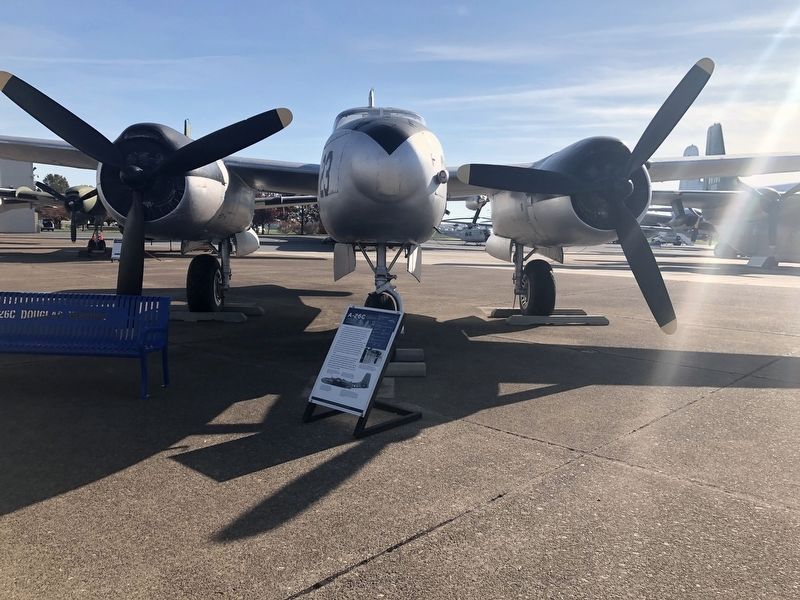Dover Air Force Base in Kent County, Delaware — The American Northeast (Mid-Atlantic)
A-26C
Invader
— S/N 44-35523 —
Intended to be built in large numbers to replace the USAAF's three medium bombers (A-20 Havoc, B-52 Mitchell, and B-26 Marauder), Douglas' A-26 Invader served briefly in Europe and the Pacific in the closing months of World War II. Pilots praised its improved maneuverability, top speed, and hitting power.
At Dover Army Air Field, Delaware, during WWII, A-26s were used to develop rocket racks, sighting devices, and load configurations that enabled a single aircraft to launch devastating attacks at hardened ground targets, ships, or trains. A maximum of 28 rockets were eventually carried on hard points under the wings, but that configuration was not ready until after the war ended.
Many orders were cancelled when the war ended in 1945, but Invaders saw action again five years later. The first and last combat missions of the 1950-53 Korean War were flown by B-26s (the A-26 was redesignated in 1948). During the Vietnam War, Invaders (once again designated A-26s in 1966) were used to bomb the Ho Chi Minh trail until 1969.
Specifications[Captions:]
Manufacturer: Douglas
Type: Three-seat light attack bomber
Powerplant: Two 2,000-hp Pratt & Whitney R-2800-79 Double Wasp radial engines
Maximum Speed: 372 mph
Range: 1,400 mi.
Service Ceiling: 22,100 ft
Max Takeoff Weight: 34,927 lb
Crew: Pilot, bombardier/navigator, and rear gunner
Weapons: Six .50 caliber machine guns, plus 4,000 lb of bombs internally
Dimensions:
Wing Span: 70 ft 0 in
Length: 51 ft 3 in
Height: 18 ft 3 in
Above: This lineup of twenty-eight 115-mm rockets represents the doubled firepower of an A-26B using a new launching method method developed by the 4146th Base Unit at Dover Army Air Field.
With the pilot were a bombardier/navigator (who normally sat next to the pilot but also had a work station in the nose) and a gunner.
The dorsal turret could be locked in the forward position at zero degrees elevation and fired by the pilot. After WWII the turrets were often removed.
Two 2,000-hp Pratt & Whitney R-2800 Double Wasp 18-cylinder radial engines powered the invader. This engine also powered the P-47 Corsair, Hellcat, and Tigercat.
The invader's gunner reached his position via a bomb bay entry hatch and remotely controlled the dorsal and ventral turrets each of which held two .50 caliber machine guns. In the gun-nose C model, the navigator also served as a gun loader for the nose armament.
Topics. This historical marker is listed in these topic lists: Air & Space
Location. 39° 7.096′ N, 75° 27.462′ W. Marker is in Dover, Delaware, in Kent County. It is in Dover Air Force Base. Marker can be reached from Heritage Road, 0.7 miles west of Bayside Drive (Delaware Route 9), on the left when traveling west. Touch for map. Marker is at or near this postal address: 1301 Heritage Road, Dover AFB DE 19902, United States of America. Touch for directions.
Other nearby markers. At least 8 other markers are within walking distance of this marker. C-130E (within shouting distance of this marker); C-123K (within shouting distance of this marker); C-7A (within shouting distance of this marker); Special Ops Memorial (within shouting distance of this marker); C-9A/C (within shouting distance of this marker); C-119C (within shouting distance of this marker); F-101B (within shouting distance of this marker); F-106A (within shouting distance of this marker). Touch for a list and map of all markers in Dover.
Credits. This page was last revised on September 17, 2023. It was originally submitted on November 13, 2019, by Devry Becker Jones of Washington, District of Columbia. This page has been viewed 157 times since then and 18 times this year. Photos: 1, 2. submitted on November 13, 2019, by Devry Becker Jones of Washington, District of Columbia.

